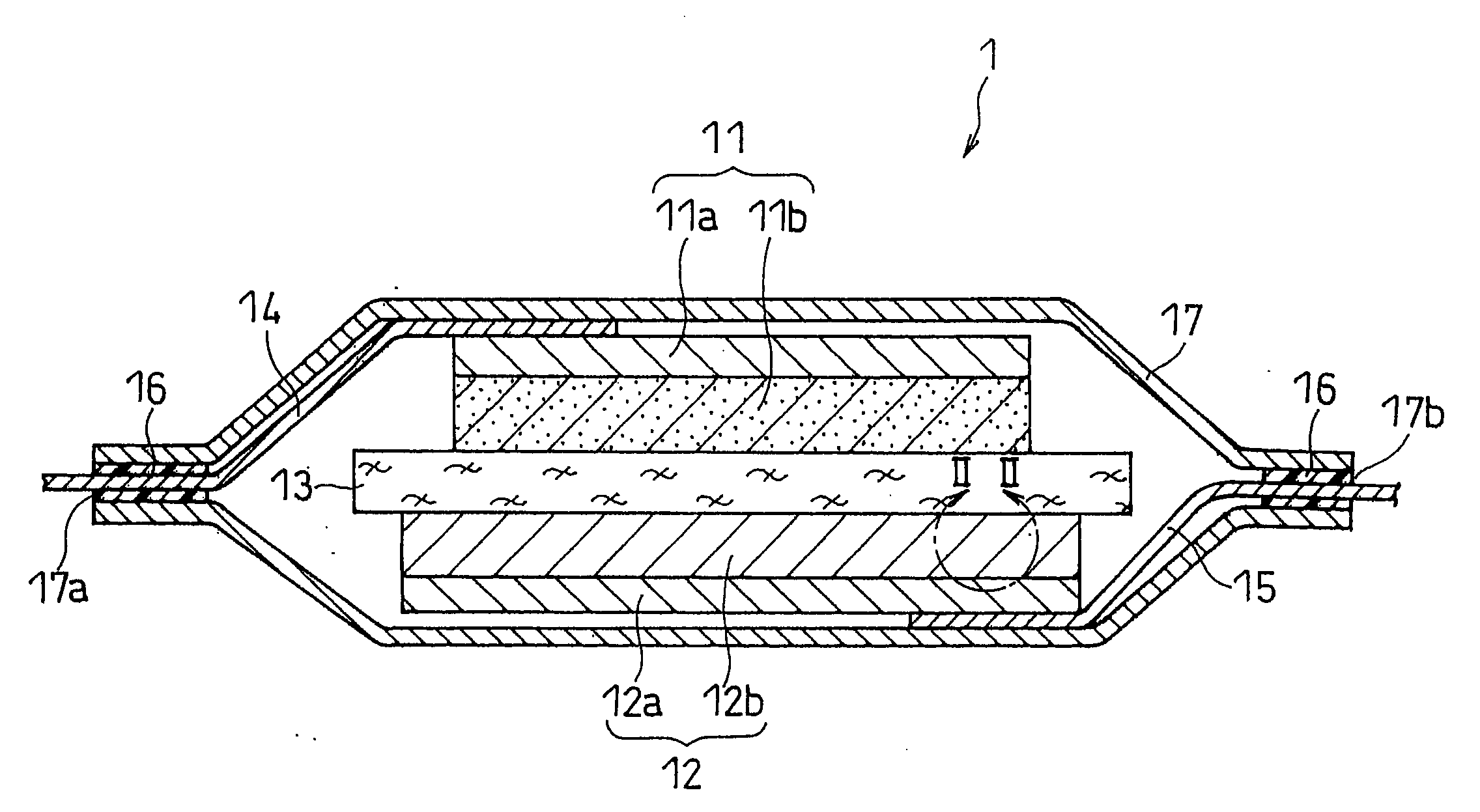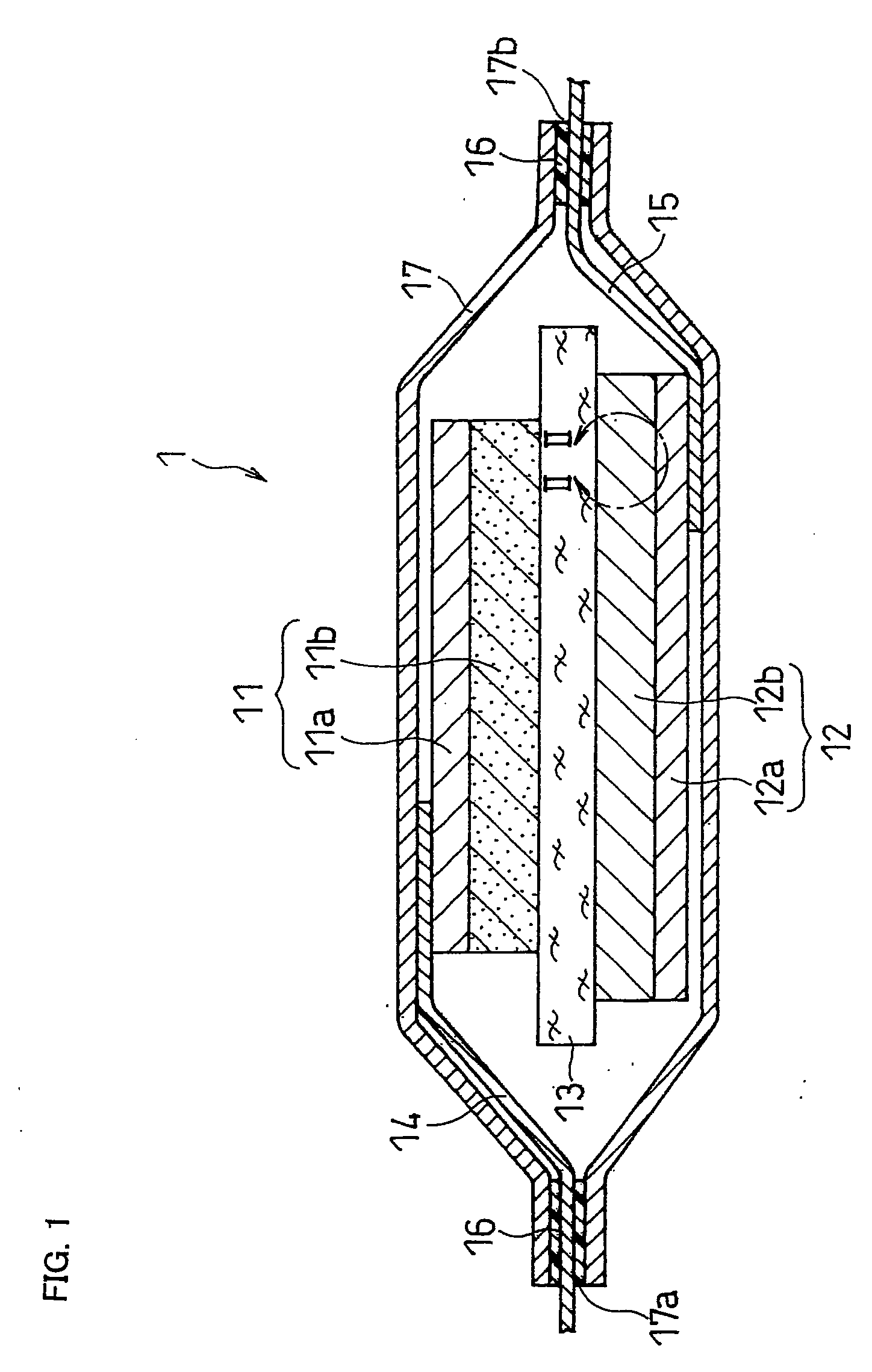Negative electrode for lithium ion secondary battery and lithium ion secondary battery
a lithium ion secondary battery and negative electrode technology, applied in the direction of secondary cell details, cell components, cell component details, etc., can solve the problems of shortening the charge/discharge cycle life, deformation of the negative electrode current collector, and increasing the size of the negative electrode, so as to improve the coulombic efficiency. , the effect of high lithium-ion conductivity
- Summary
- Abstract
- Description
- Claims
- Application Information
AI Technical Summary
Benefits of technology
Problems solved by technology
Method used
Image
Examples
example 2
[0104]This example is the same as Example 1 except that protrusion-forming rolls were produced as follows. First, a ceramic layer of chromium oxide was formed on the surface of an iron roll in the same manner as in Example 1. Using a laser, circular first holes (depressions) with a diameter of 12 μm and a depth of 3 μm were made in the surface of the ceramic layer. The first holes were arranged in the close-packed arrangement at an axis-to-axis distance of adjacent holes of 20 μm. Also, the bottom of each first hole had the same shape as the bottom of the first hole in Example 1, and the length from the surface of the ceramic layer to the center of the bottom of the first hole was 3 μm. Next, circular second holes (depressions) with a diameter of 8 μm and a depth of 3 μm were made in the bottom of the first holes so that their axes were aligned with the axes of the first holes. The second holes also had the same shape as the first holes, and the length from the surface of the cerami...
example 3
[0106]A lithium ion secondary battery of the invention was produced in the same manner as in Example 1 except that a negative electrode current collector was produced as follows.
[0107]A 6-μm thick dry film resist (trade name: PHOTEC RY-3300, available from Hitachi Chemical Company, Ltd.) was attached to the surface of a copper alloy foil (trade name HCL-02Z, available from Hitachi Cable Ltd.). Also, 8-μm diameter circular dots were printed on a resin mask. The circular dots were arranged in the close-packed arrangement at a center-to-center distance of 20 μm. This resin mask was placed on the dry film resist, irradiated with i rays using a collimated light aligner, and developed with a 1 wt % sodium carbonate aqueous solution to form a resist pattern. Next, copper protrusions were formed in the openings of the resist by a plating method. The copper alloy foil with the resist pattern was immersed as the cathode in a copper sulfate aqueous solution containing 270 g / liter of copper (II...
example 4
[0108]In the same manner as in Comparative Example 1, a copper alloy foil with circular protrusions (first protrusions) of 12 μm in diameter and 8 μm in height on the surface was prepared. These circular protrusions were arranged in the close-packed arrangement at an axis-to-axis distance of 20 μm on the surface of the copper alloy foil. This copper alloy foil was immersed in a copper sulfate aqueous solution containing 47 g / liter of copper (II) sulfate pentahydrate and 100 g / liter of sulfuric acid, and was plated at a current density of 30 A / dm2 and a liquid temperature of 50%. As a result, second protrusions (separation-stopping areas) were formed in the side faces of the circular protrusions in the circumferential direction. Further, this copper alloy foil was immersed in a copper sulfate aqueous solution containing 235 g / liter of copper (II) sulfate pentahydrate and 100 g / liter of sulfuric acid, and was plated at a current density of 3 A / dm2 and a liquid temperature of 50° C. to...
PUM
 Login to View More
Login to View More Abstract
Description
Claims
Application Information
 Login to View More
Login to View More - R&D
- Intellectual Property
- Life Sciences
- Materials
- Tech Scout
- Unparalleled Data Quality
- Higher Quality Content
- 60% Fewer Hallucinations
Browse by: Latest US Patents, China's latest patents, Technical Efficacy Thesaurus, Application Domain, Technology Topic, Popular Technical Reports.
© 2025 PatSnap. All rights reserved.Legal|Privacy policy|Modern Slavery Act Transparency Statement|Sitemap|About US| Contact US: help@patsnap.com



